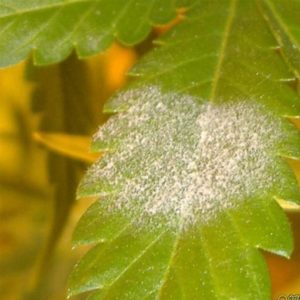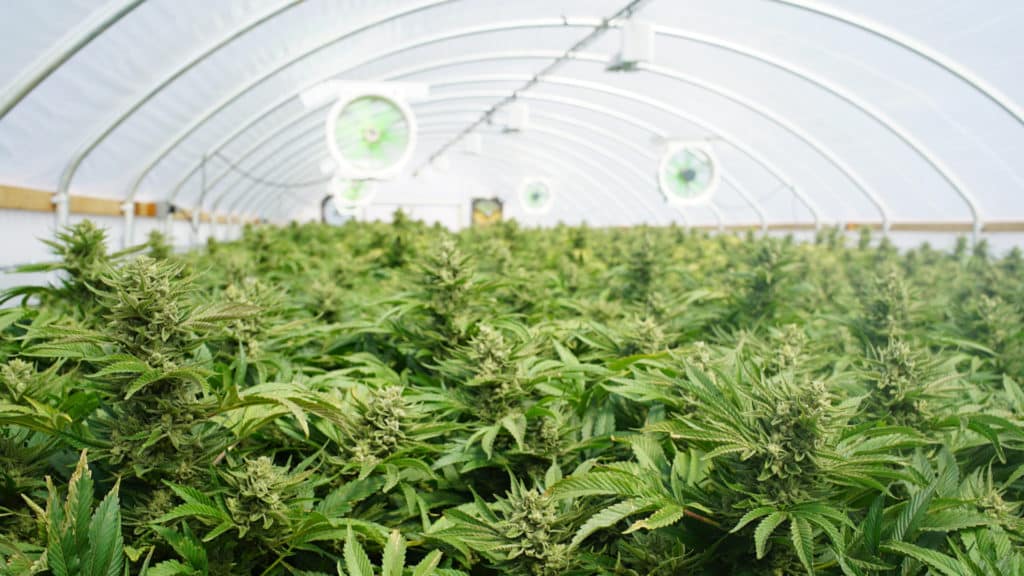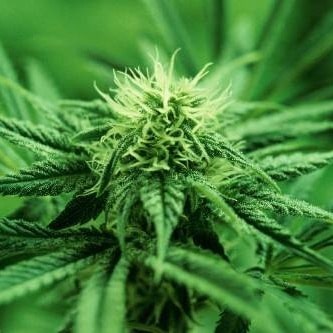Powdery mildew is caused by a variety of fungi resulting in the appearance of a white or gray powdery growth on leaves. Those species that attack hops also attack marijuana plants. Powdery mildew can appear on plants indoors or out. Before the powder forms, small bumps may be noted on the topside of affected leaves.
Mildew spores are carried by the wind, air ventilation systems, clothing, pets and just about any living thing that moves about. Mildew spores will remain dormant until environmental factors offer the optimum conditions for them to come to life. Humidity levels over 55% and warm temperatures, along with over crowding are conducive to mildew growth. Once awakened, powdery mildew spores are likely to attack young plants first. It will then spread over the entire plant, infecting stems and buds, in addition to leaves.
Powdery mildew hinders photosynthesis, crippling the marijuana harvest. If left untreated, black specks will appear in the ‘powder’. Infected buds will smell damp when infected with powdery mildew. This fungus cannot be removed from the buds. Powdery mildew will turn the cannabis plants yellow, then brown and will eventually die.
Once again, prevention is the key to maintaining a healthy cannabis crop. Give the plants plenty of room to breathe; planting too closely together gives rise to activating mildew spores. Water your marijuana at a time of day where it will receive at least five hours of light, whether natural or artificial. Installing a UVC light in the ventilation system of indoor grow rooms will help to keep errant spores from attacking your plants.
In keeping with the purpose of this section, here are some measures you can take to eliminate the threat of powdery mildew having a devastating effect on your efforts as a cannabis gardener:
- Make a solution of 2 teaspoons organic apple cider vinegar per quart of water. Spray on the plants to eliminate and/or prevent mildew growth.
- Add ½ teaspoon baking soda per quart of water. Spray.
- Oil sprays consisting of neem oil, sesame oil or fish oil work on powdery mildew as it does on many fungal diseases.
- Milk sprays have been very effective in eliminating powdery mildew. Combine 40% milk with 60% water. The milk’s protein acts with the sun to create a natural antiseptic, killing mildew as the result. Milk sprays should be applied in bright light every ten days as a preventative measure. This method can be employed to resist mildew on any garden plant.
In the event powdery mildew hits you unawares, remove any infected leaves with a plastic bag, tie it tightly closed and discard into a receptacle with a tight fitting lid. Be careful not to jolt the spores into the air during this process, thus the recommendation to use a plastic bag during the removal process. Follow with a fungicide treatment on the stems from which the infected leaves have been removed. Any of the above mentioned preventative treatments can be applied. In addition you may want to try any one of the following to help heal wounded areas of the marijuana plants:
- Cinnamon oil, garlic oil, coriander oil, clove oil, jojoba oil, cottonseed oil sprays.
- Applications containing copper, available at any garden center.
- Hydrogen peroxide added to water (1 tablespoon per gallon) oxidizes the fungus cell walls, killing it.
- Limonene (oils extracted from citrus rinds) mixed with water at the rate of one teaspoon per pint offers fungicidal properties and will aid in control, but not eradication.
- Sulfur burners as a means of control. Stay out of the area when using this treatment as it can cause respiratory inflammation in humans. Follow directions and wipe down all walls and windows when completed to remove any residue.
We have so far, covered fungal and bacterial enemies of the cannabis plant that attack the visible parts. However, disease can also attack the root systems, which is what we will now address. Strap on your boots and come on down below for a deeper look into what can be affecting a failing crop. For a great anti-mold and disease spray, check out the products at this link here.
All living organisms need a strong core to maintain optimum health. Just as humans need to ensure healthy innards for ourselves and our pets, we need to do the same for our plants, Mary Jane included. Maladies arising from the inside (or below ground) are harder to detect because the affected areas are not readily visible. As a result, we are not always aware of a problem until it’s too late. Or is it? What are the most prevalent root diseases and how can we recognize, treat and or repair? Let’s travel together and see what we can discover.
Want to know more about growing marijuana? Get a free guide about growing marijuana at this link here. Order some high quality marijuana seeds at this link here.





